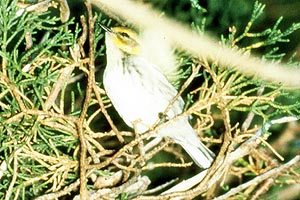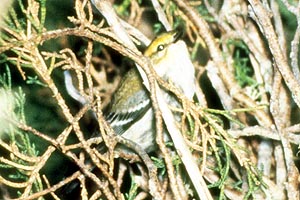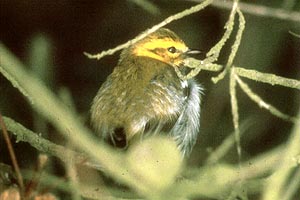


Photos © Albert Ghiorso
All rights reserved.
  |
 Photos © Albert Ghiorso All rights reserved. |
Thanks again for all the thoughtful comments and opinions. At the time several keen observers looked for and failed to see any yellowish wash on the undertail coverts or vent. In 1980 that was considered the kiss of death for any claim of Black-throated Green Warbler and the conventional wisdom was that such birds were best considered hybrids. I believe this idea may have dated back to a bird thought to be a Black-throated Green in Arizona, but when collected by Allan Phillips, it turned out to be a hybrid. However, my recollection is that the Arizona specimen was an adult male with a solid black throat concealing much of the yellow present on Townsend's Warbler. This is certainly not the case here.
Michael L. Morrison presented a talk on hybridization between Hermit and Townsend's Warblers at a meeting of the local chapter of the Cooper Ornithological Society in Berkeley some years ago. The specimens he collected predominately resembled Hermit Warblers, but with bright yellow on the breast. All Hermit X Townsend's warblers I have seen in California have been of this type. However Morrison showed a slide of one specimen in which the head was like a Townsend's Warbler, yet the breast was white. This individual appeared to show recessive traits. Evidently the Hermit Warbler head pattern, and Townsend's Warbler breast color are dominant.
If our mystery bird is a hybrid, it must certainly be of a very rare recessive type. I sent copies of these slides to Morrison, who wrote to me that he felt this bird was not a hybrid. In my opinion, this individual has too many traits which are perfect for Black-throated Green, including the unstreaked green back, the dark line through the eye, and the hollow face patch. If this bird were a hybrid, it would certainly be a very insidious individual to look so much like Black-throated Green.
In fact, the original photos appear to me to show a very faint wash of yellow across the vent. It is very subtle, but if present, it leaves no characters which are wrong for Black-throated Green. But even without this character, I think it is unwise to invoke a hybrid theory as the origin of every slightly different individual, especially when the rest of the bird seems normal. I am much more willing to accept hybrid explanations when there are two or more characters which appear to be intermediate or wrong. At the time, the regional editor of American Birds argued that there might be other phenotypes and that this bird could be a hybrid. However, I believe this bird is fine for Black-throated Green and the passage of time has not altered that opinion.
To view public comments or join the fray by adding your opinion, click here.